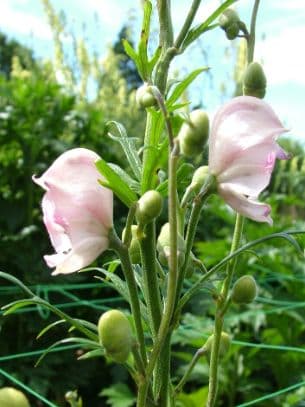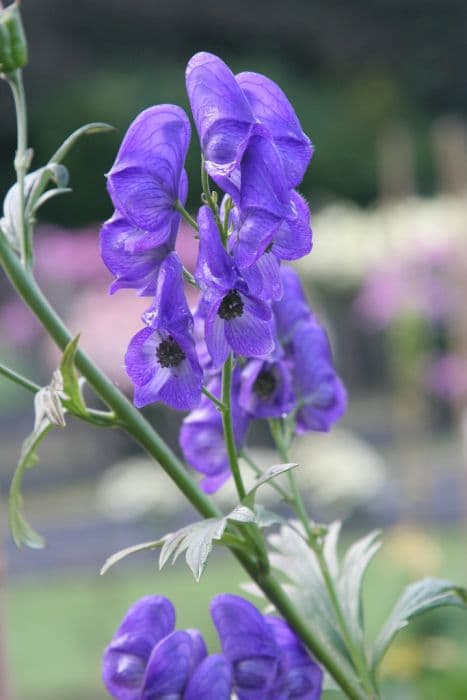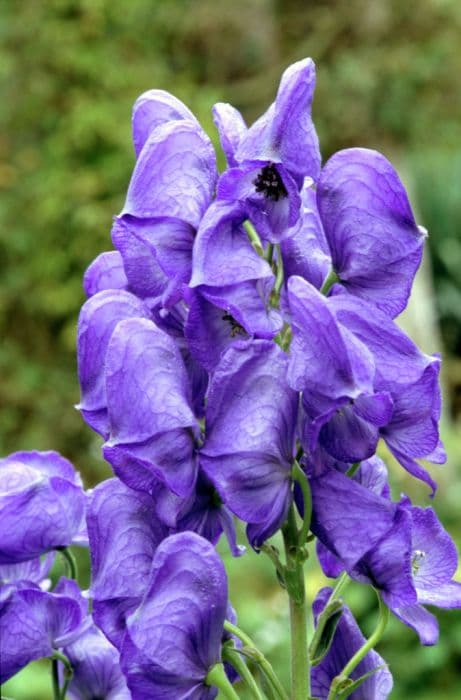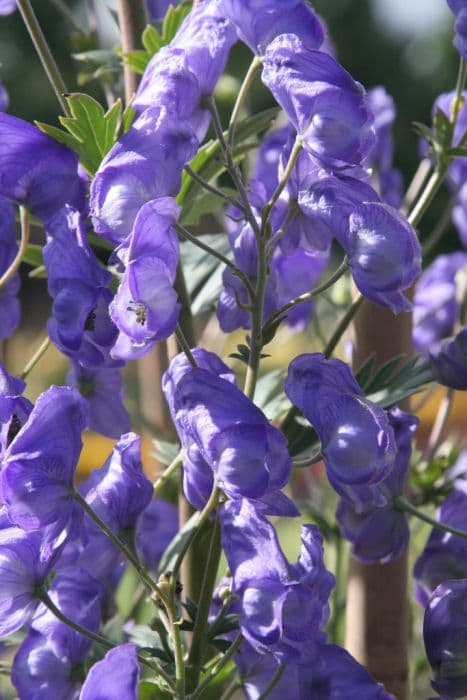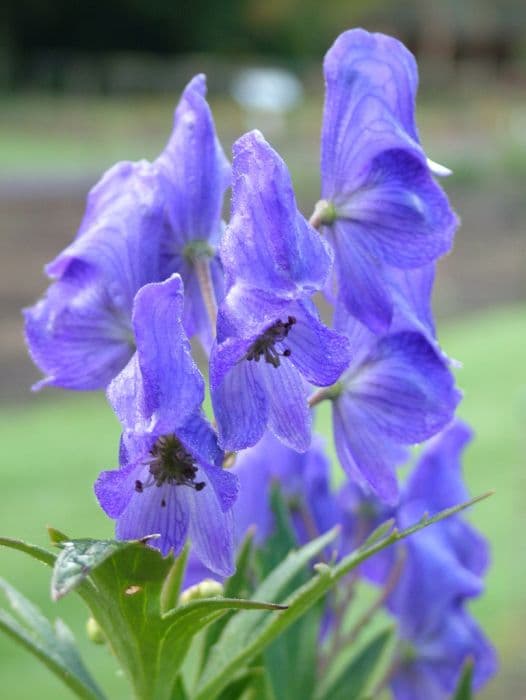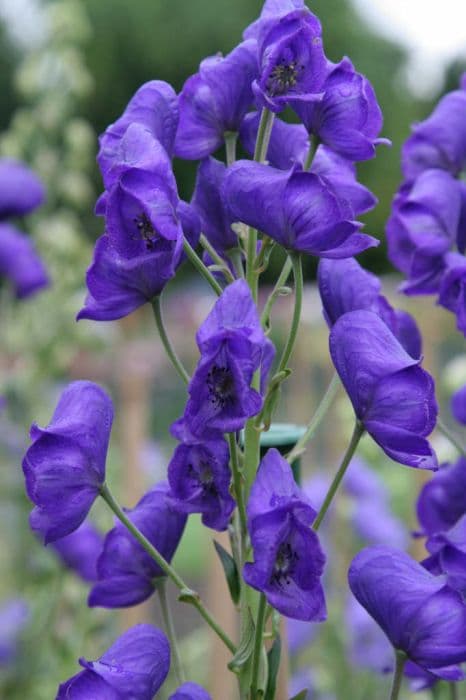Clematis Clematis 'Frances Rivis' (A)

ABOUT
The Clematis 'Frances Rivis', commonly referred to simply as clematis, is renowned for its stunning display of blooms. This variety of clematis boasts large, nodding flowers whose color can be described as a deep, velvety blue, with a touch of purple at times. Each blossom is made up of four to six, broad and overlapping petal-like segments, which can also be referred to as tepals. These tepals form a shape that is somewhat reminiscent of a classic tulip. At the center of the flowers, there is a tuft of contrasting creamy-yellow stamens which add to the visual appeal and serve as an alluring aspect for pollinators. The foliage of the Clematis 'Frances Rivis' consists of leaves that are typically bright green, providing a fresh backdrop to its dramatic flowers. The leaves are compound, often comprising a trio of smaller leaflets which can have a somewhat leathery texture. The edges of the leaflets tend toward a gentle undulated form, contributing to the plant’s overall elegance. Adorning supports such as trellises or arbors or growing along fences, the plant exhibits a climbing habit, with tendrils that reach out and enable it to attach to structures for support, allowing for a vertical display of its attractive flowers and foliage which contributes to its ornamental value in the landscape setting. This climbing nature also makes it a favorite among gardeners looking to add a vertical element to their gardens without specifying the extent of its reach. As the plant matures throughout the seasons, it is known for its robust flowering capability which often leads to a rich display that can transform a garden's aesthetic.
About this plant
 Names
NamesFamily
Ranunculaceae
Synonyms
Frances Rivis Clematis
Common names
Clematis 'Frances Rivis'.
 Toxicity
ToxicityTo humans
The common name for Clematis 'Frances Rivis' is clematis. Clematis plants are considered mildly toxic to humans. The main toxic component is an irritant called protoanemonin, which can be found primarily in the sap. If ingested, clematis may cause symptoms such as nausea, vomiting, diarrhea, and excessive salivation. Dermatitis can also occur with skin contact. It's generally advisable to handle clematis with gloves and to avoid ingesting any part of the plant.
To pets
The common name for Clematis 'Frances Rivis' is clematis. Clematis is also toxic to pets, including cats and dogs. The plant contains protoanemonin, which can cause drooling, vomiting, diarrhea, and at times, it can lead to more severe symptoms such as mouth ulcers or seizures, particularly if consumed in large quantities. Any pet ingesting clematis should be taken to a veterinarian promptly. It is important to prevent pets from accessing and chewing on this plant due to its potential for toxicity.
 Characteristics
CharacteristicsLife cycle
Perennials
Foliage type
Deciduous
Color of leaves
Green
Flower color
Blue
Height
8 feet (2.44 meters)
Spread
3 feet (0.91 meters)
Plant type
Climber
Hardiness zones
4
Native area
Europe
Benefits
 General Benefits
General Benefits- Ornamental Appeal: The Clematis 'Frances Rivis' adds aesthetic value to gardens with its attractive blue or purple flowers that bloom in spring.
- Landscape Versatility: This climber is suitable for trellises, walls, arbors, pergolas, or as a ground cover, adding versatility in garden design.
- Pollinator Attraction: The plant's flowers can attract bees and other pollinators, supporting biodiversity.
- Privacy Screen: When grown on structures, it can provide a natural privacy screen during its growing season.
- Shade Provision: Once established on pergolas or arbors, it can provide shade in garden sitting areas.
- Seasonal Interest: Offers a seasonal display of blooms in spring and often a second, less profuse, flowering later in the summer or early fall.
- Easy Pruning: Clematis 'Frances Rivis' belongs to pruning group 1, meaning it requires minimal pruning and is relatively easy to care for.
- Companion Planting: It can be combined with other plants like roses to create multi-layered garden designs.
- Durability: This variety is hardy and can tolerate cold temperatures, making it suitable for a range of climates.
- Height and Coverage: With its ability to grow up to 2-3 meters tall, it can cover unsightly features and add height to the garden.
 Medical Properties
Medical PropertiesThis plant is not used for medical purposes.
 Air-purifying Qualities
Air-purifying QualitiesThis plant is not specifically known for air purifying qualities.
 Other Uses
Other Uses- Photography Backdrop – Clematis Frances Rives, with its beautiful blue flowers, can be used as a natural and attractive backdrop for outdoor portrait photography.
- Textile Dyes – The pigments from the blue petals may be used in the natural dyeing of fabrics, providing unique hues to textiles.
- Floral Arrangements – The vines and blooms can be incorporated into floral arrangements and bouquets for an additional touch of elegance.
- Educational Tool – Gardeners and educators can use this plant to demonstrate pruning techniques and discuss climbing plant support structures.
- Habitat Enrichment – When planted in gardens, it can provide a rich habitat and shelter for beneficial insects such as pollinators and predatory insects.
- Art Inspiration – The intricate vines and vivid flowers can serve as an artistic muse for painters and other visual artists.
- Garden Sculpture – The plant’s climbing nature can be guided to grow on frames, creating living sculptures in the garden.
- Privacy Screening – When grown on trellises, Clematis Frances Rives can provide a natural privacy screen for patios or gardens.
- Craft Projects – Dried flowers and vines can be used in craft activities, such as creating wreaths, ornaments, or potpourri.
- Culinary Garnish – Though not commonly known for its flavor, the edible petals can be used as a delicate garnish for salads and desserts.
Interesting Facts
 Feng Shui
Feng ShuiThe Clematis is not used in Feng Shui practice.
 Zodiac Sign Compitability
Zodiac Sign CompitabilityThe Clematis is not used in astrology practice.
 Plant Symbolism
Plant Symbolism- Mental Agility: Clematis often represents cleverness and intellectual agility due to its complex structure and the way it climbs.
- Beauty and Artistry: With its showy flowers, Clematis suggests an appreciation for beauty and is often linked to artistic creativity.
- Ingenuity: The plant's ability to adapt and grow in various conditions symbolizes resourcefulness and innovative thinking.
- Spiritual Quest: Because Clematis vines reach upward, they are sometimes associated with a spiritual journey or aspiration.
- Traveller's Joy: This common name for some Clematis varieties is linked to the plant's capacity to grow over vast areas, symbolizing the joy of travel and exploration.
 Water
WaterThe Clematis, commonly known as Traveler's Joy, prefers even moisture and should be watered regularly to maintain slightly moist soil, especially during dry spells. A good rule of thumb is to water deeply once a week with about one gallon of water, but this may need to be adjusted based on temperature and rainfall. During the first growing season, ensure consistent watering to help establish a strong root system. In subsequent years, watering can be slightly reduced but should still be regular to encourage lush growth. Avoid overhead watering to prevent potential leaf diseases and instead water at the base of the plant.
 Light
LightTraveler's Joy thrives best in full sun to part shade conditions. A spot that provides morning sunlight with some afternoon shade is ideal, especially in hotter climates. The plant can handle more sun in cooler regions but should be protected from the intense midday sun in warmer areas to prevent foliage from scorching.
 Temperature
TemperatureTraveler's Joy can tolerate a range of temperatures and is hardy down to about -20 degrees Fahrenheit. It performs best in a temperature range between 45 and 70 degrees Fahrenheit. This plant can survive up to around 85 degrees Fahrenheit but may require additional shade and moisture to stay healthy in higher temperatures.
 Pruning
PruningPruning Traveler's Joy is important to maintain its size, encourage vigorous growth, and enhance flowering. It should be pruned in late winter or early spring, just before new growth begins. Since Traveler's Joy blooms on new wood, cutting the plant back by about a third each year can promote a lush, bloom-filled season. Avoid heavy pruning as this can reduce the blooms the following season.
 Cleaning
CleaningAs needed
 Soil
SoilClematis 'Frances Rivis', commonly known as the Clematis, thrives in well-draining, moisture-retentive soil with good fertility. A mixture of loamy garden soil, well-rotted compost, and a component of gritty sand or perlite to improve drainage makes an ideal soil base. The soil pH should be slightly alkaline to neutral, ranging from about 7.0 to 7.5.
 Repotting
RepottingThe Clematis should be repotted every 2-3 years to prevent it from becoming root-bound and to replenish the nutrients in the soil. This climbing plant prefers to have room for root growth, so ensure to provide a larger pot at each repotting stage.
 Humidity & Misting
Humidity & MistingClematis plants, including 'Frances Rivis', prefer moderate humidity levels. They do not require excessively high humidity but should not be subjected to extremely dry conditions, aiming for a relative humidity of around 40-60%.
 Suitable locations
Suitable locationsIndoor
Grow Clematis in a bright spot, ensure support for climbing, and keep soil moist.
Outdoor
Plant Clematis in sun or part shade; provide climbing support and mulch roots.
Hardiness zone
4-9 USDA
 Life cycle
Life cycleThe life cycle of Clematis 'Frances Rivis', also known as the Frances Rivis Clematis, begins with seed germination, which occurs when conditions are moist and warm. After germination, the seedling emerges and establishes itself, developing a root system and foliage as it matures into a young plant. The plant then enters its vegetative stage where it experiences rapid growth and vine elongation, supported by ample sunlight and proper care. The Frances Rivis Clematis enters its flowering stage in late spring or early summer, producing striking blue or violet flowers that attract pollinators. After pollination, the plant develops seed heads which gradually ripen, releasing seeds for dispersal by wind or animals. Finally, in fall or winter, the plant enters dormancy, reducing metabolic activity until conditions improve with the arrival of spring, thus restarting the cycle.
 Propogation
PropogationPropogation time
Spring to Summer
Propogation: Clematis 'Frances Rivis', commonly known as clematis, can be propagated most effectively during early summer by softwood cuttings or in late winter by layering. Softwood cuttings are taken from new growth that is not yet hard; these cuttings should be about 4 to 6 inches (10 to 15 centimeters) long with several leaves. The cut end of the cutting can be dipped in rooting hormone to promote root development before being placed in a well-drained potting mix. The pot should be covered with a plastic bag to maintain humidity and placed in indirect light until roots develop, after which the bag can be removed and eventually, the plant can be transitioned to the garden. Layering involves bending a low-growing stem to the ground, making a small wound on the underside of the stem, and then burying the wounded section in the soil while it is still attached to the parent plant. This encourages roots to form at the wound site. Once a healthy root system has developed, the rooted section can be cut from the parent plant and transplanted.
